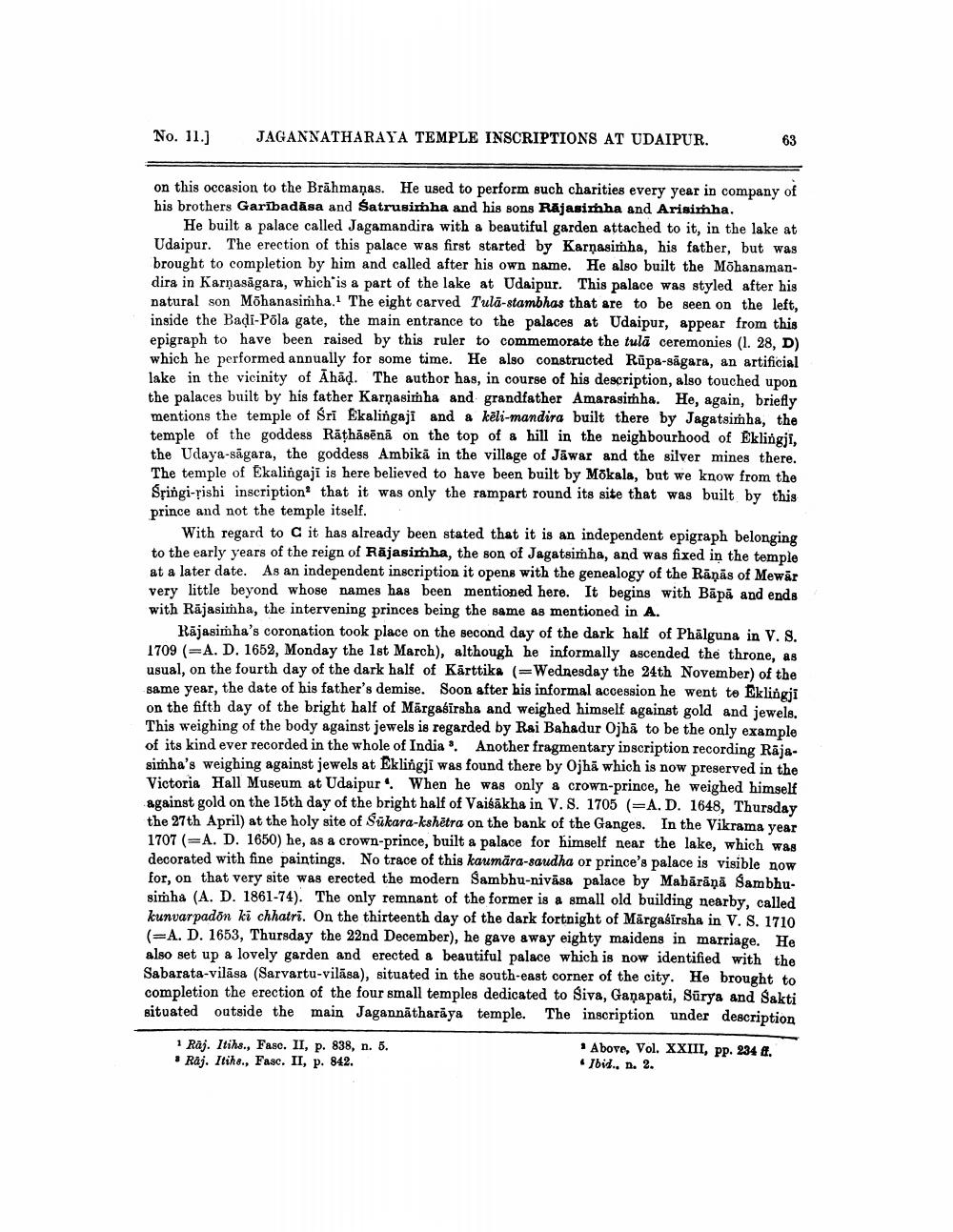________________
No. 11.)
JAGANNATHARAYA TEMPLE INSCRIPTIONS AT UDAIPUR.
on this occasion to the Brahmanas. He used to perform such charities every year in company of his brothers Garibadāsa and Satrusimha and his sons Rājasimha and Arisinha.
He built a palace called Jagamandira with a beautiful garden attached to it, in the lake at Udaipur. The erection of this palace was first started by Karnasimha, his father, but was brought to completion by him and called after his own name. He also built the Mōhanamandira in Karnasågara, which is a part of the lake at Udaipur. This palace was styled after his natural son Möhanasinha. The eight carved Tulā-stambhas that are to be seen on the left, inside the Badi-Pola gate, the main entrance to the palaces at Udaipur, appear from this epigraph to have been raised by this ruler to commemorate the tulā ceremonies (1. 28, D) which he performed annually for some time. He also constructed Rūpa-sågara, an artificial lake in the vicinity of Ahād. The author has, in course of his description, also touched upon the palaces built by his father Karnasimha and grandfather Amarasimha. He, again, briefly mentions the temple of Sri Ekalingaji and a kēli-mandira built there by Jagatsiṁha, the temple of the goddess Rātāsēnā on the top of a hill in the neighbourhood of Eklingji, the Udaya-sāgara, the goddess Ambika in the village of Jawar and the silver mines there. The temple of Ekalingaji is here believed to have been built by Mokala, but we know from the Sringi-rishi inscription that it was only the rampart round its site that was built by this prince and not the temple itself.
With regard to C it has already been stated that it is an independent epigraph belonging to the early years of the reign of Räjasimha, the son of Jagatsimha, and was fixed in the temple at a later date. As an independent inscription it opens with the genealogy of the Rāņās of Mewar very little beyond whose names has been mentioned here. It begins with Bāpā and ends with Rājasimha, the intervening princes being the same as mentioned in A.
Rājasimha's coronation took place on the second day of the dark half of Phälguna in V. S. 1709 (=A. D. 1652, Monday the 1st March), although he informally ascended the throne, as usual, on the fourth day of the dark half of Kärttika (=Wednesday the 24th November) of the same year, the date of his father's demise. Soon after his informal accession he went te Eklingji on the fifth day of the bright half of Märgaśīrsha and weighed himself against gold and jewels. This weighing of the body against jewels is regarded by Rai Bahadur Ojhā to be the only example of its kind ever recorded in the whole of India. Another fragmentary inscription recording Rajasimha's weighing against jewels at Eklingji was found there by Ojhā which is now preserved in the Victoria Hall Museum at Udaipur. When he was only a crown-prince, he weighed himself against gold on the 15th day of the bright half of Vaisakha in V. S. 1705 (=A.D. 1648, Thursday the 27th April) at the holy site of Sukara-kshētra on the bank of the Ganges. In the Vikrama year 1707 (=A. D. 1650) he, as a crown-prince, built & palace for himself near the lake, which was decorated with fine paintings. No trace of this kaumāra-saudha or prince's palace is visible now for, on that very site was erected the modern Sambhu-nivāsa palace by Mabārānā Sambhusinha (A. D. 1861-74). The only remnant of the former is a small old building nearby, called kunvarpadon ki chhatri. On the thirteenth day of the dark fortnight of Märgasirsha in V. S. 1710 (=A. D. 1653, Thursday the 22nd December), he gave away eighty maidens in marriage. He also set up a lovely garden and erected a beautiful palace which is now identified with the Sabarata-vilāsa (Sarvartu-vilāsa), situated in the south-east corner of the city. He brought to completion the erection of the four small temples dedicated to Siva, Ganapati, Sürya and Sakti situated outside the main Jagannatharaya temple. The inscription under description
1 Raj. Itihs., Fasc. II, p. 838, n. 5. • Ráj. Itihe., Fasc. II, p. 842.
* Above, Vol. XXIII, pp. 234 ft. • Ibid. n. 2.




